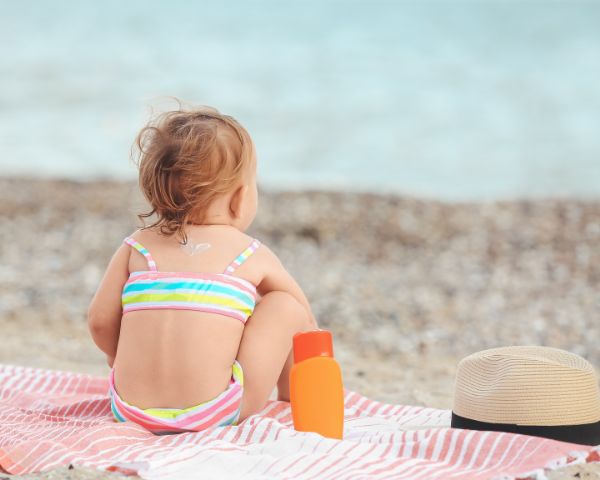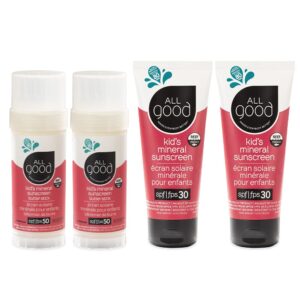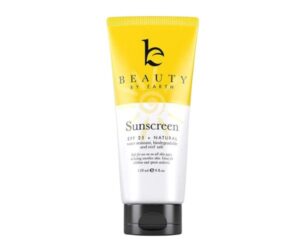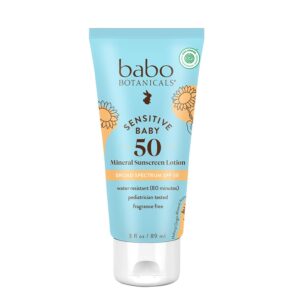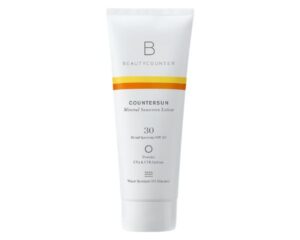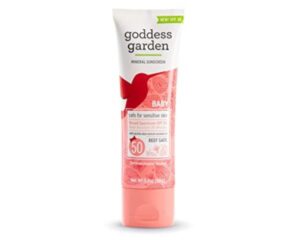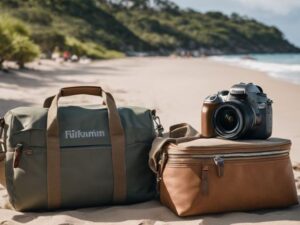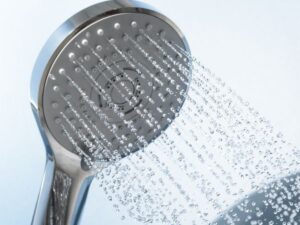Dangers of Toxic Sunscreen
Two-thirds of the majority of sunscreens mentioned in “2019 Guide to Sunscreens” did not pass safety tests conducted by the FDA. However, you can still see them on the shelves in grocery stores. Another run of testing for a dozen brands of sunscreen ingredients showed high levels of avobenzone, oxybenzone, ecamsule and octocrylene.
These chemicals can enter a person’s bloodstream after just one day of use which can harm the skin in the long run of usage. Toxic chemicals can also remain in the human body for 24 hours after being applied to the skin. [1] Most countries should start to regulate products that contain chemicals that are not good for the skin.
Chemicals such as oxybenzone and octinoxate are also contributors to coral bleaching. Almost 14,000 tons of sunscreen that enter the ocean directly affect coral reefs. Hence, it is recommended that you opt for natural sunscreens that are not harmful to the environment. [2]
Yet, most popular sunscreen brands are still using these chemicals for their sunscreen protection. These brands include Coppertone, Hawaiian Tropic, and Banana Boat, to name a few. However, we’re starting to see a trend of these big brands creating new, less toxic sunscreen made without oxybenzone and parabens.
It is advisable to get a non toxic, organic sunscreen, that contains high SPF to prevent skin cancer and does not contain any of the harmful chemicals that were previously mentioned. If you are going on a tropical beach vacation, read here about essential oils that keep mosquitoes away.
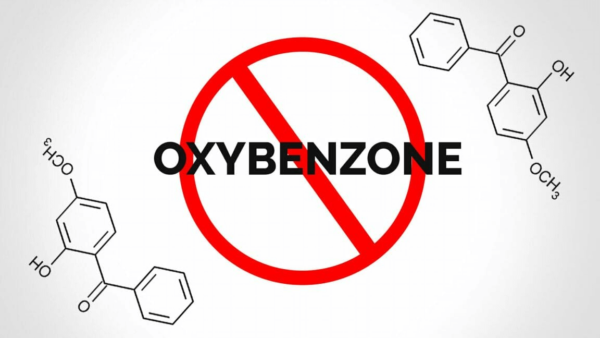
Bad Sunscreen Ingredients: List of Chemicals to Avoid in Sunscreen
1. Oxybenzone
Oxybenzone is known as a chemical that can disrupt hormones and at the same time trigger allergic reactions. Based on various tests and research, out of all the harmful ingredients that may be found in sunscreens, oxybenzone is the most worrisome because it may trigger allergic skin reactions.
Consumers are advised to avoid sunscreens with oxybenzone. But sunscreen users are exposed to other active ingredients too that can damage their health in general.
Margaret Schlumpf of the University of Zurich found that there are other sunscreen filters other than oxybenzone in Swiss women’s breast milk. This suggests that fetuses and newborns may already be exposed to these harmful substances from their mothers. [3]
She detected at least one sunscreen chemical in 85 percent of milk samples. Research has also shown oxybenzone to disrupt sperm cell function which can cause difficulty for men and their partners to bear a child.
Another study also looked at sunscreen chemicals and which ones impacted male fertility. 13 out of the 29 chemicals used in sunscreen production have the ability to disrupt calcium signaling in male sperm, which can significantly degrade the quality of sperm production. [4]
It can also lead to fertility problems in the long run which most users are not aware of. Men who had higher rates of oxybenzone circulating in their bodies had more problems getting a woman pregnant. [5] Hence, most brands nowadays are now looking for alternatives in replacing these harmful ingredients in the body. Choosing organic ingredients in your spray sunscreen can go a long way.
Not to mention these products can significantly fight UVA rays and be a good source of Vitamin E for healthy skin tone.
2. Avobenzone
This can cause adverse effects on the skin and produce dangerous free radicals. It causes premature aging for people who use this product regularly and increases the chances of getting skin problems.
Look for brands that have coconut oil, seed oil, organic jojoba seed oil, and other natural ingredients, that are not harmful to the skin. Natural sunscreens are now becoming popular in the market that does not contain avobenzone.
3. Octinoxate (Octyl methoxycinnamate)
Octinoxate is an organic UV filter. It is readily absorbed into the skin and continues to be absorbed after the sunscreen has been applied. It has been found in blood 16 times above the proposed FDA safety threshold for users who uses brands that contain this particular active ingredient. [1]
Additionally, animal studies have shown the chemical has hormone effects on the metabolic system and affects thyroid hormone production, with some evidence for other endocrine problems which include androgen and progesterone signaling. [6]
Octinoxate can also cause allergic reactions just like Oxybenzone after exposure to ultraviolet light.
4. Octisalate
Another sunscreen ingredient that can harm the skin. This particular ingredient is also used in sunscreens like other skincare products such as lip balm. It is also considered a contributor to coral bleaching.
There are many broad spectrum sunscreens available. However, do not forget to check the list of ingredients at the back and scan whether it contains Octisalate or not.
Checking out other harmful ingredients and toxic chemicals can prevent you from buying a brand that is not good for your health. Also, opt for natural sunscreens rather than chemical sunsreens that can cause skin irritation.
Determine the sunscreen Sun Protection Factor (SPF) that is found in the packaging to help you decide which one is suitable for your trip and everyday use. You also have the option to choose one that contains organic sunflower seed oil which is a good antioxidant and great source of Vitamin E.
5. Octocrylene
Octocrylene effectively absorbs UV rays keeping the skin safe from sun damage but it may also cause rare allergic reactions in the body. There are also reports that tagged Octocrylene as a contributor to coral bleaching. [2]
An alternative ingredient for this one is shea butter which contains anti-inflammatory properties. You can carry around a sunscreen stick when you leave the house in case you need another application on your skin later.
Other brands are now placing “certified organic” tags on their packaging. It shows consumers that they are making a positive effort to remove the harmful ingredients and replace them with more environmentally friendly chemicals that are also good for the skin.
Also, it is helpful if you can avoid having too much exposure to the harsh heat of the sun. For those who have sensitive skin, it is recommended that you test the sunscreen in your hand and wait for a few minutes to know whether you are allergic to the sunscreen. Once done checking, you can now choose the level of SPF that you want to have.
6. Homosalate
Homosalate is an organic UV filter widely used in U.S. sunscreens. The FDA has proposed that there is insufficient data to evaluate whether it is safe and effective to use in sunscreens. Homosalate has been found to penetrate the skin, disrupt hormones, and produce toxic breakdown byproducts over time that are not good for humans. [7]
A recent opinion from the European Commission found that homosalate was unsafe to use at concentrations up to 10 percent and recommended a maximum concentration of 1.4 percent, because of concerns for potential endocrine disruption.
The FDA allows U.S. sunscreen manufacturers to use it in concentrations up to 15 percent.
7. Retinyl palmitate
Vitamin A derivative called retinyl palmitate has been connected to skin lesions and tumors on sun-exposed skin. According to 2012 research by U.S. government experts, applying retinyl palmitate to the skin when it is exposed to sunlight may hasten the growth of skin lesions and tumors. [8]
Retinyl palmitate and other vitamin A compounds in cosmetics have been linked to vitamin A toxicity when mixed with excessive sun exposure, according to officials and scientists that looked into the components of this chemical.
People who have oily skin may have problems with the type of sunscreen that they can use. Soybean oil and different types of coconut oil must be avoided by consumers that have this skin type. There are brands that offer oil-free sunscreen with high SPF. Mineral sunscreens can be a great alternative.
8. The “Dirty Dozen” ingredients
The “Dirty Dozen” ingredients include parabens, phthalate, PEG, parfum (a.k.a. fragrance) and sodium lauryl/laureth sulphate. It is harmful to your skin. Instead, choose non toxic sunscreens that are reef-safe. You can also find products that contain zinc oxide which is responsible for blocking harmful UV rays from the sun.
9. Category II ingredients
Based on existing data, the FDA concluded that two active ingredients often found in sunscreen, PABA (amino benzoic) and trolamine salicylate, are unsafe and have been placed in Category II. These two active ingredients are not used in any sunscreens currently marketed in the United States, but keep your eyes open if you have an old bottle lying around somewhere.
Oxybenzone, octocrylene, and avobenzone also massively impact coral reefs, leading to coral bleaching. They are also toxic to fish and marine life. While wearing chemical sunscreen might be fine on the odd occasion when exploring a city on foot, please make sure to take care when going swimming in natural areas and opt for mineral sunscreen instead.
Nanoparticles particularly nano titanium dioxide have been linked to speeding up the aging of the skin and problems during pregnancy. [8]
Beware of the term ‘mineral based’ which just means that zinc oxide or titanium dioxide has been mixed with chemical sunscreen ingredients. You can also consult your dermatologist to help you find the perfect sunscreen that will suit your skin type. Make sure to be aware of other toxic ingredients such as parabens, cyclic silicones, BHA/BHT etc.

Sunscreen Ingredients to Look Out For
Zinc Oxide
One of the top two ingredients used in mineral sunscreen works by forming a layer on the skin and reflecting UVA and UVB rays from the surface of the skin. To be particular, Zinc is well-recommended for UV Protection. It also has properties that can significantly promote skin healing, as well as an acne treatment.
It has the capacity to treat minor skin irritations and prevent too much skin damage when you are under the sun. You do not have to spend on expensive brands but rather opt for these ingredients that are found in most natural sunscreens in the market today.
Titanium Dioxide
Zinc Oxide and Titanium Dioxide are the only two active ingredients in safe and non toxic sunscreen formulas you must first check when buying sunscreen. Avoid nano titanium dioxide and instead look out for non-nano titanium dioxide because it sits on your skin and not be absorbed. [9] All sunscreens recommended in this post use either non-nano zinc oxide or non-nano titanium oxide which is good for you.
How Do UV Ray Work?
UV rays affect the skin that may cause sunburn and irritation. It can also cause severe damage to the skin tissue if there is prolonged exposure to the sun. An adverse response to exposure to UVB rays is sunburn. It is the result of the body’s defensive mechanism towards harsh sun exposure without any sunscreen applied to the skin. [10]
When you go out on a sunny day, the UV radiation is absorbed by melanin and released as heat. The first reaction of the body towards the heat is to shield nearby cells from further damage from blue light by sending out melanin when it detects solar damage.
The skin darkens as a result of the pigment if there is no layer of protection applied before sun exposure. This is why it is important to always bring sunscreen lotion with you for better sun protection. UVB penetrates the outermost layer of the skin and causes damage. Overexposure then leads to sunburn and even blistering.
UVB rays are generally the culprit behind painful sunburns. UVA on the other hand, is associated with skin aging. UVA penetrates the skin more deeply and causes tanning. This causes DNA damage and is responsible for premature skin aging.
Both UVA and UVB exposure leads to skin damage and DNA mutation. Hence it is important to protect your skin.
How Does SPF Work?
SPF measures how well it protects the skin from sunburn. It is also important to understand that SPF rating refers to UVB rays only. It can be your first line of defense when going out on a sunny day or if you have an upcoming vacation on the beach. In fact, it is a must-have when going out during summer to prevent any sunburn or skin irritation.
Experts at Raw Elements USA discussed that the amount is being measured in percentages and is not one linear scale. For example, if you have SPF 15, it can significantly block 93% of UVB rays from the sunlight.
When you buy an SPF 30 sunscreen lotion or stick, it has the ability to block 97% of UVB rays. While having an SPF 50 can protect you from 98% of UVB rays. Therefore, a sunscreen SPF of 50 only provides 1% more protection compared to those brands that offer SPF 30.
In addition, look for ingredients like aloe barbadensis leaf extract and juice, green tea, camellia sinensis leaf extract, and grape seed oil. These are additional ingredients that you can find in a natural sunscreen with a good SPF component.
What Does Broad-Spectrum Mean and Why Do We Want it?
SPF rating refers to UVB rays only whereas “broad spectrum” describes a sunscreen that provides protection against both UVA and UVB rays. In 2011, the FDA released new rules requiring sunscreen in the market to meet both UVA and UVB standards for protection before being able to be labeled as broad spectrum.
Ensure you choose a sunscreen labeled broad spectrum and is SPF 30 or higher. This combination will help protect and withstand the effects of harmful rays coming from the sun. Saying that, be sun safe and protect yourself.

What are Sun Safe Tips?
Seek shade between 11 am-3 pm when the sun is at its peak. Do not put yourself out there under the sun when it’s noon time. It is expected that the UV rays are strong and can severely harm your skin if you stay outside.
Also, you should use a cover-up when going out if the sun is still up. It can reduce the heat that is directly hitting your skin. A hat can also provide extra protection. You can also wear your sunglasses to give your eyes extra protection from sunlight. It would be painful in your eyes if you had a glimpse of the sun without it.
And last but not least, invest in a certified organic sunscreen with good SPF components to to protect your skin.
What is Mineral Sunscreens and How Does it Work?
Both zinc oxide and titanium dioxide are ingredients used in mineral sunscreens. They work by providing a layer of protection over your skin. This is different to chemical sunscreens whereby UV light gets absorbed into the skin. The chemicals in the sunscreen cause a chemical reaction and UV light is converted into heat and heat dissipates from the skin.
How to Choose an Effective Non Toxic Sunscreen
Use Broad-Spectrum SPF 30
Are you still confused about what SPF should you buy? Here is a quick explanation for you that can guide you toward finding the perfect sunscreen for your skin type. Scientists suggest that the Broad-Spectrum SPF 30 is considered the benchmark needed to help the skin be protected from UVB and UVA rays. Not getting enough sun protection can lead to skin problems and health issues. [11]
Take note that getting a higher SPF will not automatically give you a higher or stronger layer of protection under the sun. So having a lotion with SPF 50 or more can give you a false sense of security.
Choose ʻWater-Resistant 80 Minutesʼ
The term ‘Water-Resistant 80 Minutes’ is defined by the FDA as a sunscreenʼs capacity to protect the skin after 80 minutes of exposure to sweat and water. If you are going on a beach trip with your friends or family, it is recommended that you choose a product that is tested to be ‘water-resistant 80 minutes’.
A product that is Water-Resistant 80 Minutes will likely offer better sweat resistance as well. It can be used by athletes and those who tend to sweat a lot. However, you may require re-application when necessary.
Avoid sprays or powder sunscreens
Avoid sprays or powder sunscreens because they are made up of chemical ingredients that can be a health hazard. When inhaled, there is a chance that the lungs will absorb the harmful chemicals which can result in health problems and at the same time pollute the environment.
Another issue with this type of sunscreen is it can easily be rubbed off your skin after contact with clothing or skin.
15 Best Non Toxic Sunscreen Brands
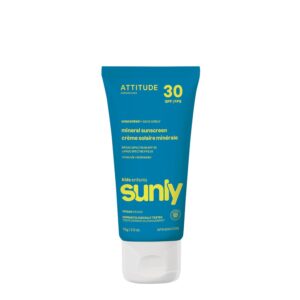

ATTITUDE Mineral Sunscreen for Baby and Kids
The ingredients found in this product are reef safe and it will not cause coral reef destruction. It is also fragrance-free which is perfect for those people who do not want a strong scent in their lotion.
It contains SPF 30 which can adequately protect the skin from harmful rays coming from the sun.
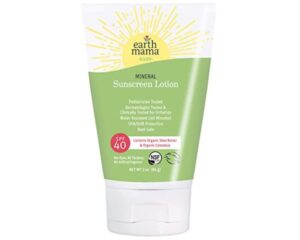
Earth Mama Baby Face Mineral Sunscreen Stick SPF 40
Earth Mama Baby Face Mineral Sunscreen has SPF 40 and is water resistant for 40mins. It is made from natural ingredients for all skin types and has been pediatrician tested, dermatologist tested and clinically tested for irritation.
All Good Baby & Kids Mineral Face & Body Sunscreen, SPF 50
This type of sunscreen is unscented and has a soothing effect on the skin. It is also suitable for those who have sensitive skin types.
It is non-greasy and can be applied evenly on the skin. The ingredient list of the product also shows that there are no additives that can cause adverse reactions to the skin.
Beauty by Earth Mineral Sunscreen, SPF 25
This product from Earth contains SPF 25 which can block 94-96% of UVB rays from the sun.
It’s filled with skin-nourishing ingredients like coconut oil, aloe vera, and shea butter.
Babo Botanicals Sensitive Baby Mineral Sunscreen, SPF 50
This sunscreen from Babo Botanicals contains SPF 30 and it is dermatologically tested. It is lightweight, fragance-free and water resistant for 80 minutes.
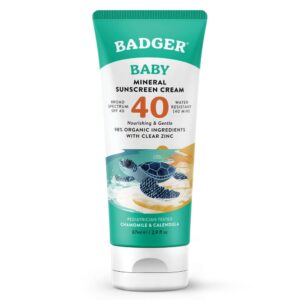
Badger Baby Reef Safe Natural Mineral Sunscreen Cream with Clear Zinc Oxide, SPF 40
It is hypoallergenic and contains sunflower and jojoba oil. These ingredients are moisturizing for the skin, which provides 40 mins of water resistance. It is pediatrician tested & approved safe for babies & kids.
Beautycounter Countersun Mineral Sunscreen Lotion, SPF 30
Beautycounter Countersun Mineral sunscreen with SPF 30 contains non-nano zinc oxide that protects the skin against sun rays and is reef safe.
This sunscreen is water resistant for 40 minutes.
Goddess Garden Organics Baby Mineral Sunscreen, SPF 50
This baby mineral sunscreen is easy to apply to the skin. It contains lavender and coconut scent which is good for people who love scented sunscreen with good SPF components.
It provides a wide-spectrum of UVA and UVB protection.
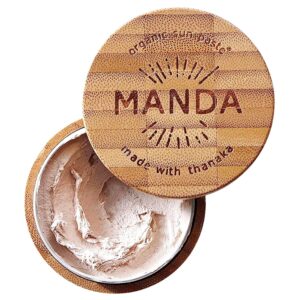
MANDA Organic Sun Paste, SPF 50
This sun paste with SPF 50 is popular with people who are very active such as bikers, surfers, hikers, and athletes.
Once applied, it is light on your skin but provides thick protection. Includes Thanaka, extracted from the wood of a tree native to Myanmar, used as a natural sun protectant that preserves and beautifies the skin. It offers anti-inflammatory, anti-aging and moisturizing properties.
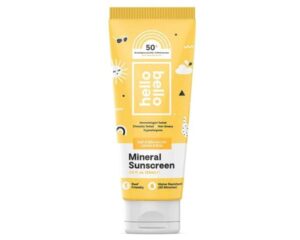
Hello Bello Baby Mineral Sunscreen Lotion, SPF 55+
This sunscreen with SPF 50 and has broad spectrum protection. It is clinically tested and water resistant for 80 minutes.
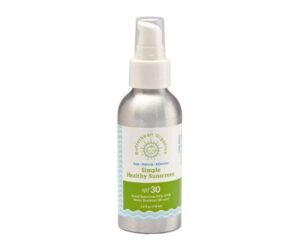
Butterbean Organics Simple Healthy Sunscreen, SPF 30
The product is made from certified organic ingredients and is water resistant up to 80 minutes.
It also uses polyhydroxystearic acid which is used to stabilize the sunscreen and create smooth even coverage which ultimately protects your skin better.
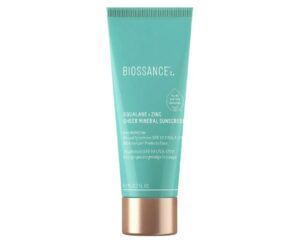
Biossance SQUALANE + ZINC SHEER MINERAL SUNSCREEN
This sunscreen is lightweight but deeply moisturizing. It offers 97% protection against UVB rays that will cause skin irritation and sunburns. One of the ingredients used is water lily, which helps cool and calm skin after UV exposure and heat stress.
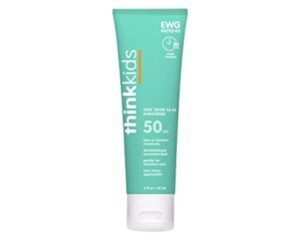
Thinksport Kids Mineral Sunscreen, SPF 50+
ThinkSport kids safe sunscreen offers broad spectrum UVA and UVB coverage. It is a hydrating sun cream that won’t leave your skin feeling oily.
This sunscreen is water-Resistant for 80 minutes.
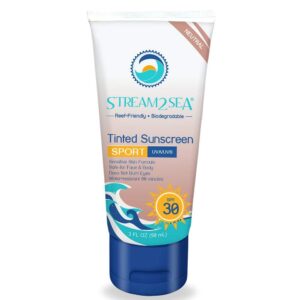
STREAM 2 SEA Tinted Sunscreen, SPF 30
This product uses a blend of over 200+ antioxidants including green tea to deliver vitamins, electrolytes to your body. Tested and proven safe for freshwater fish and saltwater fish.
This sunscreen has a natural tint to reduce the whitening effect of mineral sunscreens.
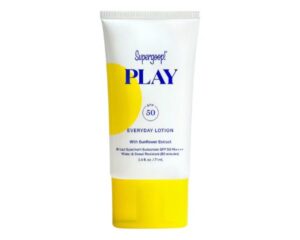
Super Goop Play Everyday Lotion, SPF 50
This is pediatrician tested, france-free and hypoallergenic. It is hydrating and provides up to 80 minutes of water resistance.
Choose Non Toxic Sunscreen for Your Health
In this article, we have managed to research the most recommended sunscreens based on customer reviews and feedback. At the end of the day, everyone has different requirements for sunscreen, from sensitive skin, the feel of sunscreen on your skin, to the tint of sunscreen.
Based on that, it is best to choose and try out different sunscreen. Nonetheless, don’t forget to practice sun safe tips and protect yourself and your loved ones by using mineral sunscreen whenever you are out and about.
Read here if you are breast pumping and looking for the best breastmilk cooler bag for when you travel.
References:
[1] Matta et al; Effect of Sunscreen Application Under Maximal Use Conditions on Plasma Concentration of Sunscreen Active Ingredients. A Randomized Clinical Trial. JAMA (2019)
[2] Danovaro et al; Sunscreens Cause Coral Bleaching By Promoting Viral Infections. Environmental Health Perspectives. (2008)
[3] Schlumpf et al; Exposure patterns of UV filters, fragrances, parabens, phthalates, organochlor pesticides, PBDEs, and PCBs in human milk: correlation of UV filters with use of cosmetics. Chemosphere. (2010)
[4]Rehfeld et al; EDC IMPACT: Chemical UV filters can affect human sperm function in a progesterone-like manner. Endocrine Connections. (2018)
[5] Franco Scinicariello and Melanie C. Buser; Serum Testosterone Concentrations and Urinary Bisphenol A, Benzophenone-3, Triclosan, and Paraben Levels in Male and Female Children and Adolescents: NHANES 2011–2012. Environmental Health Perspectives (2016)
[6] Guarnotta et al; Impact of Chemical Endocrine Disruptors and Hormone Modulators on the Endocrine System. International Journal of Molecular Sciences. (2022)
[7] Krause et al; Sunscreens: are they beneficial for health? An overview of endocrine disrupting properties of UV-filters. International journal of andrology. (2012)
[8] Su et al; Pregnancy exposure of titanium dioxide nanoparticles causes intestinal dysbiosis and neurobehavioral impairments that are not significant postnatally but emerge in adulthood of offspring. Journal of Nanobiotechnology. (2021)
[9] Crosera et al; Titanium Dioxide Nanoparticle Penetration into the Skin and Effects on HaCaT Cells. International Journal of Environmental Research and Public Health. (2015)
[10] Michaela Brenner and Vincent J. Hearing; The Protective Role of Melanin Against UV Damage in Human Skin. Photochem Photobiol (2008)
[11] Sander et al; The efficacy and safety of sunscreen use for the prevention of skin cancer. CMAJ : Canadian Medical Association Journal = journal de l’Association medicale canadienne. (2020)

